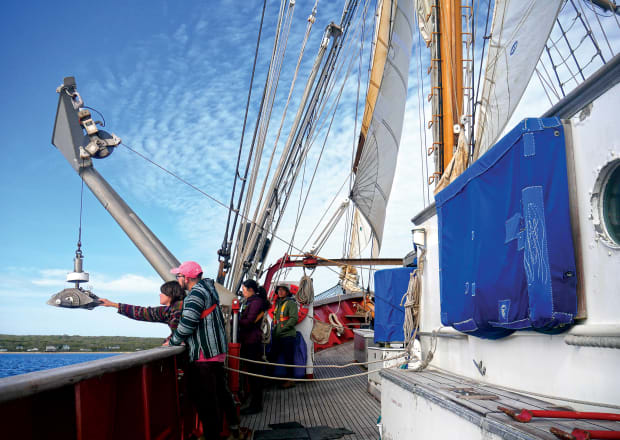
At 2330, 100 miles out to sea, the Corwith Cramer is a flurry of activity—furling headsails to slow the boat down, deploying equipment into the black water below, logging reams of data into five different logbooks scattered around the ship. What’s the engine oil pressure? What’s the cloud coverage like? How many copepods are in this petri dish? There is a page and a person for everything.
The Corwith Cramer is a 134-foot, steel, purpose-built brigantine that the Sea Education Association (SEA) uses for scientific discovery and research. Each semester and several times a summer, cohorts of students arrive in Woods Hole, Massachusetts, for a two-part program that marries in-classroom learning with up to six weeks of field work with scientists at sea, in the Atlantic or Pacific. The ship’s scientists also conduct research and collect data for NOAA, particularly in hard-to-reach places. Despite the list of things college students are required to go without while onboard—internet, candy, and music to name a few—it’s a popular program.
I arrived on a foggy May afternoon, ready to shut my phone off and sail out of email range. After a long, gray spring with a new doomsday headline every morning, I’ll admit life on land was getting to me, and I was eager to cast off for 10 days away from it all as a visiting journalist on board.
Unfortunately, the day we were meant to leave arrived with weather as foggy and bleak as I felt. We were completely socked in, and the lack of wind kept us at the dock overnight. When the breeze still didn’t materialize in the morning, we set off under power, leaving Woods Hole and heading into Vineyard Sound and, ultimately, the North Atlantic.
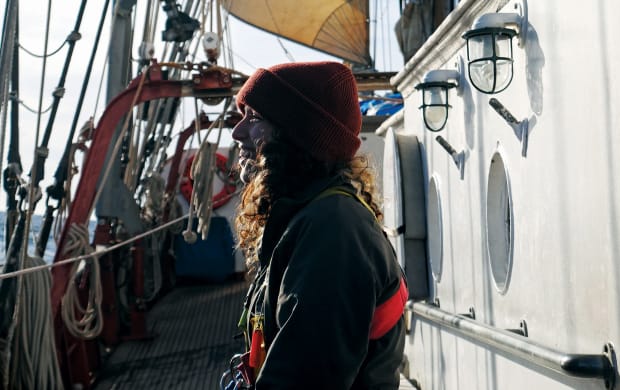
For three days, we motored and stared into the void of bright, chilly fog. The mates and scientists kept us busy by introducing procedure after procedure. Where is every fire extinguisher on board? How do you deploy this equipment? How do you deploy that equipment? How do you plot a course? We practiced crew overboard drills. We dragged out the firehoses. We got a crash course in using a sextant and finding local north. Two dozen students, who had scarcely a few weeks’ worth of sailing experience between them, struggled into survival suits and laughingly batted each other with the claw-like mittens.
In addition to the tutorials, we had plenty of time to settle into our watch schedules and get the lay of the ship. The quarterdeck was the center of operations from where the mates managed their watch and a student helmed the ship. Each mate also had a corresponding scientist who handled all of the deployments and data collection.With designated lab spaces, a literal boatload of specialized gear, and a science deck designed to make launching equipment into the water possible via a crane and a massive spool of wire, the Corwith Cramer was a marine scientist’s dream.
The space belowdecks was centered around a common area skirted with bunks and trisected by two long, gimbaled dining tables. Putting a mug of tea down in front of you was an act of faith, since the tables appeared to swing alarmingly back and forth. At least once per meal, someone accidentally rested an elbow on the table and sent everything careering towards them.
Each of us was assigned a coffin-like bunk that had to fit all of our belongings for the duration. Mine was to starboard all the way forward, which made for a bouncy ride but was preferable to the bunks near the dining area, which were intermittently subject to the cheerful noise of young people out to sea for the first time.
Aft was the engine room, sealed by airlock doors. Inside, the generator and engine made the space stiflingly hot and loud enough to drown out your own thoughts. Earmuffs were a must. During our initial tour of the boat, the chief engineer explained the fire suppression system, briefly summarized as this: If there’s a fire, an alarm rings and you have 90 seconds to get out of the chamber before the doors seal and the oxygen gets replaced, suffocating the flames—and also you. We all stared at her in horror.
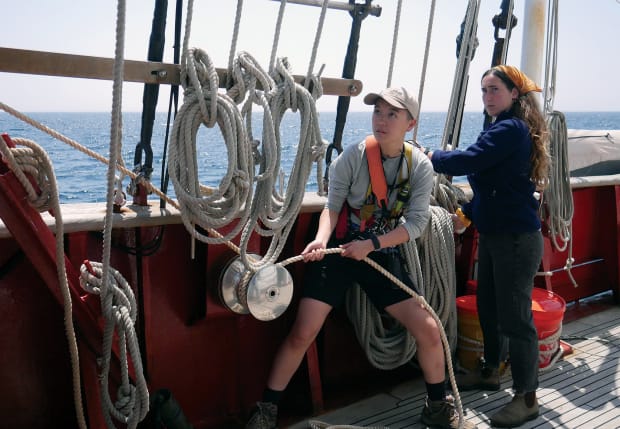
Getting Our Sea Legs
The chronology of time is difficult to keep track of when you’re on a watch schedule for days on end, and it was scarcely 48 hours in when I first heard someone ask how many days we’d been out. The lingering time confusion only got worse, but soon enough we were all comfortably, if a bit tiredly, settled into the routine.
Admittedly, I was counting the hours with a little bit of grouchiness because we still had no wind, and I was becoming increasingly worried that my sailing article was going to be a motoring article. Adding to that frustration, I was lonely out there. The students mostly came to the boat as friends already, and the crew was so close they were practically family. But there was just one of me. It was a long couple of days.
Then, on the third day, I woke and immediately knew something had changed. The boat was moving differently. I dashed up on deck to find, joy of joys, sails unfurled and a cold, clear sky.
Despite my cheerful appreciation, the new motion quickly felled several students. Seasickness procedure on the boat was to head to the quarterdeck (fresh air, less bouncing) and tether yourself in (vomit overboard, stay onboard). I’ll admit that it made me laugh to see a pile of green 20-somethings leashed to the side of the boat like pets waiting outside while their owners are in a store. Then I had to laugh again when, an hour later, I was bested by my own overconfidence and joined them.
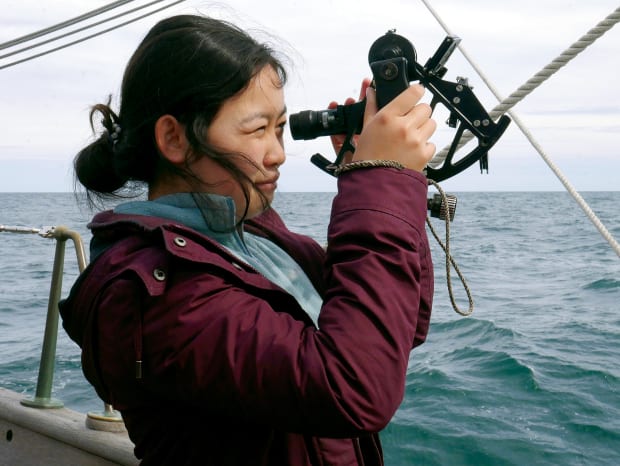
Christine practices lining up a sextant.
They greeted me with low-energy solidarity, and my watchmate, Lando, peeled herself off the deck to clip me in when I seemed in danger of dry heaving. All in all, it was great for team bonding, if not for morale. Fortunately for me, my seasickness strategy is simple and well tested: take a nap for an hour, feel fine when I wake up. Lando wasn’t so lucky and wound up taking medications like clockwork throughout the rest of the trip.
The next day, the on-watch crew was busy with sail changes, so another watchmate, Kly, and I took it upon ourselves to tackle the dishes. He was a quiet, cheerful guy and the youngest member of our crew at just 19. Elbows deep in soap suds, we got to talking about our lives on land. He told me about his family back home and his childhood best friend. Between growing up in Miami and going to school in Chicago, he’d never been anywhere so remote as the open ocean. We chatted until we ran out of dishes, and I started to feel better.
Kly, Lando (armed with a max dose of meds), and I were on watch that night with the three other members of our squad: Christine, Christian, and Sandy. Sandy was a 60-something admissions worker for SEA, and she and I teamed up to do boat checks. These essentially amounted to mini scavenger hunts to check the bilge, oil pressure, day tank fuel levels, exhaust temperature, cold storage temperatures, etc. A laminated sheet listing acceptable ranges and a fat grease pencil were used to record the numbers before transferring them into the official log. Then we checked that the fire extinguishers were in place, and that no water was accumulating in the heads, and that the chemical storage wasn’t leaking… This had to happen every hour all day, all night. Underway, at anchor, at the dock. We were forever boat checking.
During watches, our mate, Holly, kept us rotating through tasks on the hour. It helped to pass the time during a long night. Kly took over for me at the helm, and I headed up to the bow with a walkie-talkie and a pair of binoculars. Bow watch was a chilly job, standing still and constantly being buffeted by wind, but it was the thing I’d been looking forward to most. It’s just you, the waves, and the stars up there. In the distance, I saw a few pinpricks of light: a far-off fishing fleet. The night was bracing and silent. I had brought a pair of fat, fluffy mittens that our whole watch had been taking turns with when on bow watch, and despite feeling my nose turning pink, I was cozy. To my left, a streak of light rained down to the horizon.
I radioed back to the quarterdeck. “Kly, shooting star off the port beam.”
A long second later, he radioed back. “I can’t believe we’re really out here.”

Science at Sea
Around day four, I accidentally glimpsed myself for the first time in the tiny mirror in the mop closet where we showered. I looked feral. My cheeks were blotchy with the cold; my eyes were swollen.
Finally, the watch I’d been dreading rolled around: lab time. Christine and I were scheduled to do a Neuston tow and collect samples from the carousel. I tried to make it clear to her that I was as out of my depth in a lab as she was trimming sails, but she shushed me, obviously underestimating my ineptitude.
The Neuston tow was a full-watch activity since it required sail as well as science maneuvers. Protocol required that we tow equipment for exactly 30 minutes at 2 knots. Holly joked that the SEA crew contained some of the best sailors in the world—at sailing poorly. Quickly I realized that she was not kidding. Keeping a tall ship moving at exactly 2 knots requires a tactical combination of changing sail angle and backwinding any number of the mains, topsails, and headsails. In any other circumstances, bobbing along at 2 knots in no particular direction wouldn’t be much to brag about, but not on the Corwith Cramer.
The tow itself was a sort of scientific basking shark, with a long mesh body that tapered down to a collection jar at the end. It scooped up surface-level critters, debris, and what, as far as I could tell, was just sea slime. After Christine and I maneuvered it over the side, it had to be babysat for the duration of the tow, so I clipped in and peered over the side.
All mariners will recognize my contentment at this point, riding the gentle swell of the waves without a single obligation in the world other than to stare out at the gray water. It was peaceful. Kelly brought me a flaky almond pastry still warm from the galley, and to say it was bliss would be an understatement. Once you get used the routine, there’s nothing so healing as the simplicity of life at sea.
After getting the Neuston tow out of the water and sea goo safely stored for observation, Christine and I moved on to collecting water samples from the carousel. The previous watch had already done the hard part—lowering the massive contraption into the water via a crane that took five people to operate. The carousel was ringed with compartments that sealed shut at different depths, collecting water samples every 10 feet down to the ocean floor.
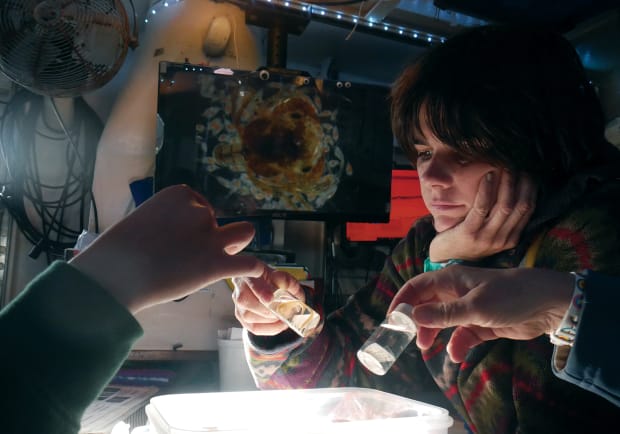
Our job was to bottle the samples for testing and analysis.
You’d think transferring water from one container to the next would be fairly straightforward, except that each sample had to be divided into five different triple-rinsed bottles with different fill amounts for different experiments (opaque bottles for measuring things that react to light, half-full plastic bottles destined for the freezer, and so on). To put it gently, my efforts were about what you’d expect from someone whose last foray into science was in high school. When I finally managed to get a bottle-for-water-without-bubbles properly bubble-free, I was so excited to show Christine that I promptly knocked it over. We laughed ourselves breathless.
Time continued to pass in a strange whirlwind, so it came as a bit of a surprise when we learned it was our final day at sea. It was also the first day that it was almost warm (mid-60s on the water is still pushing it in my opinion). I lay in the headrig at the bow, watching the sea go by below me and never wanting to leave. At least, not until I heard gentle music drifting up from the quarterdeck. I climbed back on board and found Kelly strumming a small banjo while Christine sang softly. Every single cloud that I’d arrived with had burned off.
Corwith Cramer
LOA 134 ft
LOD 98 ft
Draft:12.5 ft
Beam 26 ft
Sail Area 7,500 sq ft
Displacement 280 tons
Built 1987 by ASTACE Shipyard, Bilboa, Spain
For more about the Corwith Cramer and SEA’s history and programs, visit sea.edu.
Photos by Lydia Mullan
March 2023








